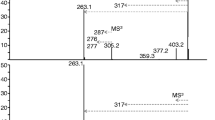Abstract
The human cDNA clone UDPGTh2, encoding a liver UDP-glucuronosyltransferase (UDPGT), was isolated from a λgt 11 cDNA library by hybridization to mouse transferase cDNA clone, UDPGTm1. The two clones had 74% nucleotide sequence identities in the coding region UDPGTh2 encoded a 529 amino acid protein with an amino terminus membrane-insertion signal peptide and a carboxyl terminus membrane-spanning region. In order to establish substrate specificity, the clone was inserted into the pSVL vector (pUDPGTh2) and expressed in COS 1 cells. Sixty potential substrates were tested using cells transfected with pUDPGTh2. The order of relative substrate activity, was as follows: 4-hydroxyestrone > estriol >2-hydroxyestriol > 4-hydroxyestradiol > 6α-hydroxyestradiol > 5α-androstane-3α, 11β, 17β-triol=5β-androstane-3α, 11β, 17β-triol. There were only trace amounts of glucuronidation of 2-hydroxyestradiol and 2-hydroxyestrone, and in contrast to other cloned transferase, no gulcuronidation of either the primary estrogens and androgens (estrone, 17β-estradiol/testosterone, androsterone) or any of the exogenous substrates tested was detected. A lineweaver-Burk plot of the effect of 4-hydroxyestrone concentration on the velocity of glucuronidation showed an apparent Km of 13 μM. The unique specificity of this transferase might play an important role in regulating the level and activity of these potent and active estrogen metabolites.
Similar content being viewed by others
References Cited
Bock, K. W., Lienblum, W. and Pfiel, H., Functional Heterogeneity of UDP-Glucuronosyltransferase activities in C57BL/6 and DBA/2 Mice.Biochem. Pharmacol., 31, 1273–1277 (1982).
Church, G. and Gilbert, W. J., Genomic sequencing.Proc. Natl. Acad. Sci. U.S.A., 81, 1991–1995 (1984).
Classen, E. and Doull A., Biotransformation of xenobiotics: Cassaret & Doull's toxicology, MacMillan P.C., New York, pp. 113–198, 1996.
Dong, M. S., Owens, I. S. and Sheen, Y. Y., Cloning and expression of human liver UDP-glucuronosyl-transferase cDNA, UDPGTh2.Arch. Pharm. Res., 20, in press (1997).
Dutton, G. J.,Glucuronidation of drugs and other compounds. CRC Inc., Florida USA pp. 69–78, 1980.
Fournel-Gigleux, S., Jackson, M. R., Wooster, R. and Burchell, B., Expression of a human liver cDNA encoding a UDP-glucuronosyltransferas catalysing the glucuronidation of hyodeoxycholic acid in cell culture.FEBS Lett., 243, 119–122 (1989).
Harding, D., Fournel-Gigleux, S., Jackson, M. R. and Burchelle, B., Cloning and Substrate Specificity of a human phenol UDP-glucuronosyltransferase expressed in COS-7 cells.Proc. Natl. Acad. Sci. U.S.A., 85, 8381–8385 (1988).
Horwitz, K. B. and McGuire, W. L., Estrogen control of progesterone receptor in human breast cancer.J. Biol. Chem., 253, 2223–2228 (1978b).
Horwitz, K. B. and McGuire, W. L., Antiestrogen mechanisms of action and effects in breast cancer: Breast cancer advances in research and treatment. Plenum Press, New York vol 2, pp. 155–204, 1978a.
Jackson, M. R., McCarthy, L. R., Harding, D., Wilson, S., Coughtrie, M. W. H. and burchell, B., Cloning of a human liver microsomal UDP-glucurosyltransferase cDNA.Biochem. J., 242, 581–588 (1987).
Katzenellenbogen, B. S., Miller, M. A., Mullick, A. and Sheen, Y. Y., Antiestrogen action in breast cancer cells: Modulation of proliferation and protein synthesis and interaction with estrogen receptors and additional antiestrogen binding sites.Cancer Res. Treat., 5, 231–243 (1985).
Katzenellenbogen B. S., Norman, M. J., Eckert, R. L., Peltz, S. W. and Mangle, W. F., Bioactive, estrogen receptor interactions, and plasminogen activator-inducing activities of tamoxifen and hydroxytamoxifen in human breast cancer cells.Cancer Res., 44, 112–119 (1984).
Katzenellenbogen, B. S., Bhakoo, H. S., Fergson, E. R., Lan, N. C., Tatte, T., Tsai, T. L. and Katzenellenbogen, J. A., Estrogen and antiestrogen action in reproductive tissues and tumors.Recent Pro. Hormon Res., 35, 259–300 (1979).
King, W. J. and Greene, G. J., Monoclonal antibodies localize estrogen receptor in nuclei of target cells.Nature (Lodon), 307, 745–747 (1984).
Kimura, T. and Owens I. S., Mouse UDP glucuronosyltransferase cDNA and complete amino acid sequence and regulation.Eur. J. Biochem., 168, 515–521 (1987).
Kirkpatrick, R. B., Falany, C. N. and Tephly, T. R., Glucuronidation of Bile Acids by Rat Liver 3-OH Androgen UDP-Glucuronyltransferase.J. Biol. Chem., 259, 6176–6180 (1984).
Kornfeld, R. and Kornfeld, S., Assembly of asparagin-linked oligosaccharides.Ann. Rev. Biochem., 50, 555–583 (1981).
Mackenzie, P. I., Hjelmeland, L. H. and Owens, I. S., Purification and Immunochemical Characterization of a Low Form of UDP Glucuronosyltransferase from Mouse Liver.Arch. Biochem. Biophys., 231, 487–497 (1984).
Mackenzie, P. I., Rat liver UDP-glucuronosyltransferase.J. Biol. Chem., 262, 9744–9749 (1986a).
Mackenzie P. I., Rat liver UDP-glucuronosyltransferase.J. Biol. Chem., 161, 14112–14117 (1986b).
Matern, H., Matern, S. and Gerok, W., Isolation and Characterization of rat Liver Microsomal UDP-Glucuronosyltransferase Activity toward Chenodeoxycholic Acid and Testosterone as a Single Form of Enzyme.J. Biol. Chem., 257, 7422–7429 (1982).
Miller, M. A. and Katzenellenbogen, B. S., Characterization and quantitation of antiestrogen binding sites in estrogen receptor-positive and-negative human breast cancer cell lines.Cancer Res., 43, 3094–3099 (1983).
Rorke, E. A. and katzenellenbogen B. S., Effects of estrogen and antiestrogens on estrogen receptor dynamics and the induction of progesterone receptor in MCF-7 human breast cancer cells.Cancer Res., 42, 139–144 (1982).
Rose, T. K., Welsch, W. J., Sefton, B. M., Esch, F. S. and Ling N. C., Vesicular Stomatitis virus glycoprotein is anchored in the viral membrane by a hydrophobic domain near the COOH terminus.Proc. Natl. Acad. Sci. U.S.A., 77, 3884–3888 (1980).
Sheen, Y. Y. and Katzenellenbogen B. S., Antiestrogen stimulation of the a 37,000 molecular weight secreted protein and estrogen stimulation of the 32,000 molecular weight secreted protein in MCF-7 human breast cancer cells.Endocrinol., 120, 1140–1151 (1987).
Sheen, Y. Y., Ruh, T. S., Mangel, W. F. and Katzenellenbogen B. S., An antiestrogenic potency and binding characteristics of the triphenylethylene H1285 in MCF-7 human breast cancer cells.Cancer Res., 45, 4192–4199 (1984).
Sheen, Y. Y., Simpson, D. M. and Katzenellenbogen, B. S., An antiestrogen of the role of antiestrogen-binding sites in mediating the growth modulatory effects of antiestrogens: Studies using t-Butylphenoxyethyl diethylamine, a compound lacking affinity for the estrogen receptor.Endocrinol., 117, 561–564 (1985).
Wishhart, G. J., Functional heterogenesity of UDP-glucuronosyltransferase as indicated by its differential development and inducibility by glucocorticoid.Biochem. J., 174, 485–489 (1978).
Author information
Authors and Affiliations
Rights and permissions
About this article
Cite this article
Ahn, M.R., Owens, I.S. & Sheen, Y.Y. Expression of human liver 3, 4-catechol estrogens UDP-Glucuronosyltransferase cDNA in COS 1 cells. Arch. Pharm. Res. 20, 465–470 (1997). https://doi.org/10.1007/BF02973941
Received:
Issue Date:
DOI: https://doi.org/10.1007/BF02973941




